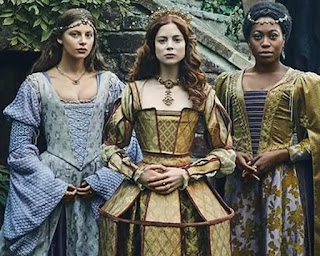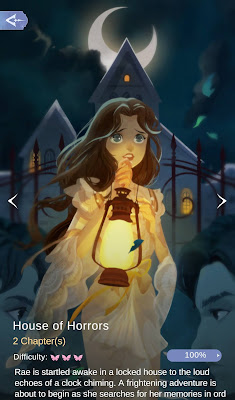Yesterday, the Starz network released the series finale of The Spanish Princess, concluding The White Queen trilogy of miniseries that began in 2013. Based on a book series called The Cousins' War by Phillippa Gregory, the trilogy covers the women who stood behind the men in power in the English monarchy from 1464 to the 1530s, preceding the first two sovereign queens, Mary and Elizabeth. The White Queen, The White Princess, and The Spanish Princess grant us a rare opportunity to see what life was like for medieval monarchs. Watching them reminded me of why I prefer the fairy tale versions of royalty. Those stories do not contain the gory deaths, gruesome births, and invasive politics that historical dramatizations like these exemplify. In fact, I had very little interest in watching the second season of The Spanish Princess until I watched some historical videos and learned that the king that Catherine of Aragon was married to was none other than King Henry VIII, who was famous for being a sexist pig that killed wives who didn't give him male heirs. That made me curious about Queen Catherine's future. Unfortunately, the series ended before introducing Henry's relationship with Anne Boleyn, who played a significant role in Catherine's downfall.

Of the three miniseries, my favorite was The White Queen, because it started out so innocent compared to the other two. It is about Elizabeth Woodville, a noble lady from the House of Lancaster who appealed to King Edward IV of the enemy House of York to recover her late husband's property. Instead of merely giving back her land, Edward decided to marry her and make her his queen even though they came from two households that stood against each other due to the
Wars of the Roses. The "White" part of The White Queen part stems from the House of York's symbol being a white rose, while the House of Lancaster is represented by a red rose. This is the closest that the trilogy gets to a
classic "Cinderella" love story in which a woman of lower rank rises to power because of a royal's love for her. However, there is no fairy tale ending for Queen Elizabeth. The rest of the miniseries spirals into a
Game of Thrones-style race for power that forces Elizabeth to take drastic means to protect her children's claim to the throne. The White Princess premiered four years later in 2017 and picks up with Elizabeth's daughter, also named Elizabeth, who reluctantly marries into the throne and schemes to keep the royal bloodline in her family.

The Spanish Princess premiered in 2019 and takes place 15 years after The White Princess took the throne when Princess Catherine of Aragon is summoned to England to marry Arthur, the son of Queen Elizabeth, who has noticeably aged. I found it amusing that the creators of the show did such a good job making Elizabeth and Henry VII look older, while Catherine and Henry VIII look exactly the same throughout both seasons of The Spanish Princess even though it spans over 20 years of their lives. A frumpy dress and updo do little to make Catherine appear to be a middle-aged queen, and the scruffy beard Henry grows at the end of the show looks laughable over his baby face. The Spanish Princess was the only one of the three miniseries to run for two seasons, spanning 16 episodes instead of the usual 10. The first season covers Catherine's short-lived marriage to Prince Arthur and her subsequent attempts to marry his brother, Henry, by convincing everyone that her marriage with Arthur was never consummated before his untimely demise. The second season, which concluded yesterday, covers her unhappy marriage to Henry as he slowly descends into madness over his obsession with having a male heir.

Catherine of Aragon is not a likable character, which made it difficult for me to enjoy this portion of the trilogy. She is introduced in the first episode of The Spanish Princess as a spoiled brat who expects everything to be handed to her on a silver platter. She becomes more sympathetic over time due to being cast aside after Prince Arthur's death and suffering a number of tragic miscarriages during her marriage to Henry. Her second marriage is built on love at first but degrades due to Henry's overwhelmingly sexist nature. The show is very dark with no humor and few to no pleasant moments for any of the characters. My favorite character, Lady Margaret Pole, suffered just as tragic of a downfall as everyone else in The Spanish Princess. I wouldn't recommend this show if you are looking for something uplifting. The numerous childbirth scenes are painful to watch, whether they end in miscarriages or not. The series ends on a hopeful note with Catherine placing her dreams for the future on her daughter, Mary, but anyone who studied history knows that the infamous Bloody Mary brings anything but hope for the future of the English monarchy.
Thus concludes a seven-year run of miniseries about the women behind the men in power that led up to the first sovereign queen. Personally, I found these miniseries more educational than enjoyable. The writers don't try to sugarcoat any aspect of medieval life and may have portrayed it as gloomier than it actually was. Surely people living in such extravagance must have had at least a few moments of happiness in their lives, right? I wouldn't recommend binge watching these series, as every episode is extremely heavy and usually involves some sort of death or trauma. If you are a fan of princesses and fairy tales, it serves as a nice reminder of why people from such a depressing era needed stories of magic and romance in their lives. It also reminds us to be grateful to live in a time where women are not seen as lesser beings, and having a daughter is no longer viewed as a curse from a higher power.












Comments